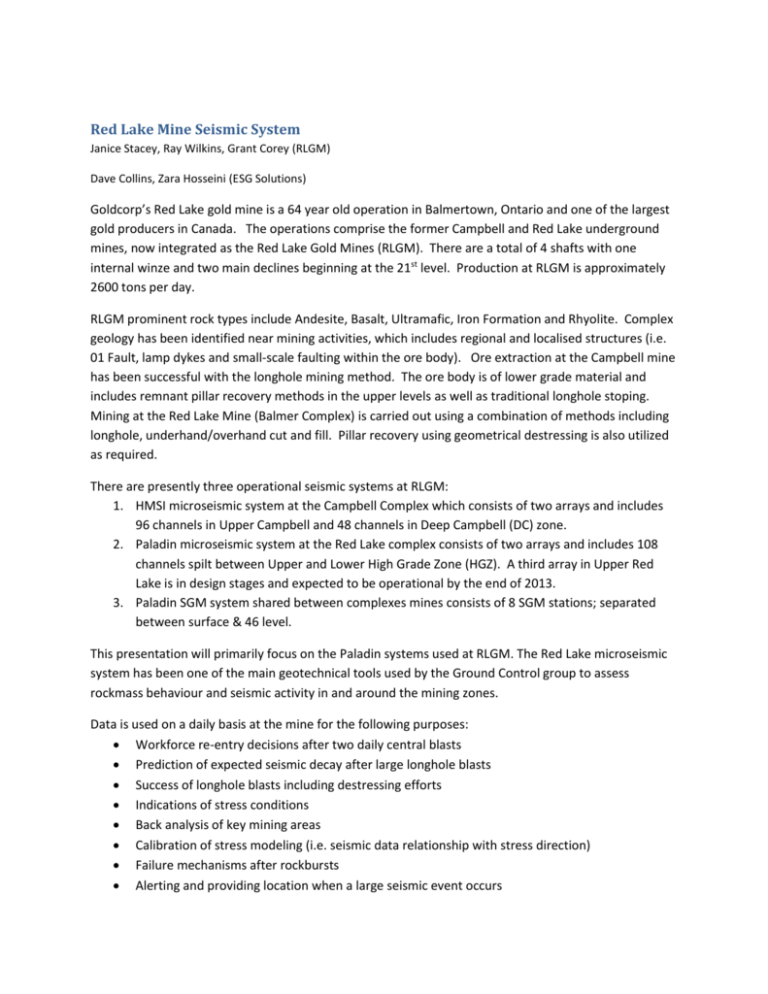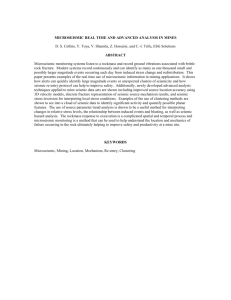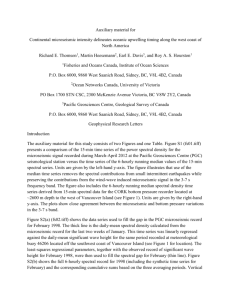Red Lake Mine Seismic System - The Gibson Group
advertisement

Red Lake Mine Seismic System Janice Stacey, Ray Wilkins, Grant Corey (RLGM) Dave Collins, Zara Hosseini (ESG Solutions) Goldcorp’s Red Lake gold mine is a 64 year old operation in Balmertown, Ontario and one of the largest gold producers in Canada. The operations comprise the former Campbell and Red Lake underground mines, now integrated as the Red Lake Gold Mines (RLGM). There are a total of 4 shafts with one internal winze and two main declines beginning at the 21st level. Production at RLGM is approximately 2600 tons per day. RLGM prominent rock types include Andesite, Basalt, Ultramafic, Iron Formation and Rhyolite. Complex geology has been identified near mining activities, which includes regional and localised structures (i.e. 01 Fault, lamp dykes and small-scale faulting within the ore body). Ore extraction at the Campbell mine has been successful with the longhole mining method. The ore body is of lower grade material and includes remnant pillar recovery methods in the upper levels as well as traditional longhole stoping. Mining at the Red Lake Mine (Balmer Complex) is carried out using a combination of methods including longhole, underhand/overhand cut and fill. Pillar recovery using geometrical destressing is also utilized as required. There are presently three operational seismic systems at RLGM: 1. HMSI microseismic system at the Campbell Complex which consists of two arrays and includes 96 channels in Upper Campbell and 48 channels in Deep Campbell (DC) zone. 2. Paladin microseismic system at the Red Lake complex consists of two arrays and includes 108 channels spilt between Upper and Lower High Grade Zone (HGZ). A third array in Upper Red Lake is in design stages and expected to be operational by the end of 2013. 3. Paladin SGM system shared between complexes mines consists of 8 SGM stations; separated between surface & 46 level. This presentation will primarily focus on the Paladin systems used at RLGM. The Red Lake microseismic system has been one of the main geotechnical tools used by the Ground Control group to assess rockmass behaviour and seismic activity in and around the mining zones. Data is used on a daily basis at the mine for the following purposes: Workforce re-entry decisions after two daily central blasts Prediction of expected seismic decay after large longhole blasts Success of longhole blasts including destressing efforts Indications of stress conditions Back analysis of key mining areas Calibration of stress modeling (i.e. seismic data relationship with stress direction) Failure mechanisms after rockbursts Alerting and providing location when a large seismic event occurs The microseismic system efficiently covers the main mining zones between 30 and 48 levels and records events as small as -3.0 moment magnitude using accelerometers. The SGM stations provide a detailed recording of large events’ magnitudes that associate to microseismic data using SGMA software. Red Lake’s seismic system has significantly been expanded and calibrated over the past couple of years to provide accurate coverage in new mining horizons (i.e. High Grade zone at depth, Sulphides and FW zones). An array of 15Hz geophones was designed for the Upper Red Lake zone to monitor mid-range magnitude events, while the microseismic system in HGZ zone was specifically design with the capability to record small magnitude events with accurate locations. In addition to hardware expansions, Red Lake has also been helping to customize the seismic software to meet their specific monitoring requirements. The seismic database is maintained on site by ground control personnel and routine maintenance is provided by ESG. Detailed analysis performed on the system by ESG has included array design analysis, system calibrations, picking optimizations and historic data processing with up to date processors. An accurate database of seismicity has been created, which allows ground control personnel to safely monitor mining activities and use the system to its full capabilities. This paper reviews the microseismic system installed at RLGM with emphasize on the Paladin system and discusses some of the system expansions and software customizations over time. Some examples of the applications of the system at the mine and some advanced analysis studies and results will also be demonstrated.










